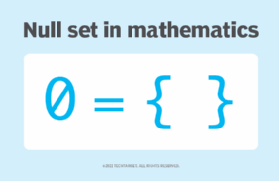null set
What is a null set in mathematics?
In mathematical sets, the null set is a set that does not contain any values or elements. It is expressed as { } and denoted using the Greek letter �� (phi). A null set is also known as an empty set or void set.
There is only one null set because, logically, there's only one way that a set can contain nothing. The null set provides a foundation for building a formal theory of numbers.
In mathematics, a set is a collection of objects or elements. A null set or empty set is a set that contains no elements. It is denoted as ∅ = { }. The intersection of two disjoint sets -- two sets that contain no elements in common -- is the null set.
For example:
Set 1 = {1, 3, 5, 7, 9, ...}
Set 2 = {2, 4, 6, 8, 10, ...}
The two sets have no elements in common. Therefore, the null set is denoted as the following:
∅ = { }

Null set notations
The letter ∅ is commonly used to represent a null set. This symbol, introduced by a group of mathematicians called the Bourbaki group in 1939, is still used today. The curled brackets { } indicate that a set has no elements inside it.
Importance of null set
The null set is important in set theory, particularly in discrete mathematics. In both number theory and set theory, the null set serves as a zero. In other words, the role of the null set in set theory is analogous to the role of zero in arithmetic and numbering systems.
A null set simplifies calculations and is often used to classify odd or rare items or to express nonexistent items. Mathematicians use null sets to build sets of natural numbers and the sets of integers and rational numbers.
The concept is also used to derive and prove many mathematical rules and formulas. It makes it possible to explicitly define the results of operations on certain sets that would otherwise not be explicitly definable.
For instance, the set of integers between zero and one is the empty set because there are no integers between zero and one. Similarly, the null set shows that there are no prime numbers between five and six.
Examples of null sets
There are an infinite number of examples of null sets.
Example 1
Set B = {y: all three-digit numbers between 90 and 99}
The lowest three-digit number is 100. Since no three-digit numbers exist between 90 and 99, Set B is a null set.
Example 2
Set C = {z: z3 = 8, z is a fractional number}
The only number that satisfies the condition is z = 2, which is not a fractional number but a whole number. Thus, Set C cannot contain any numbers and is, therefore, a null set.
Example 3
Set D = {n: n = whole numbers less than 1}
Since there are no whole numbers that are less than 1, Set D = { }.
Cardinality of null sets
The cardinality of a set refers to its size, that is, the total number of elements present in the set. For instance, Set Z = {1,2,4} contains three elements, so its cardinality is three. Empty sets do not contain any elements, so their cardinality is zero. This is also why zero is defined as the cardinality of the null set. It is also why a null set is a finite set.
Null set properties
Cardinality is one of the most important properties of a null set, with its value always fixed at zero. In addition, a null set is always a subset of every other set. Yet, a null set has no subsets, i.e., no other set can be a subset of a null set.
Other important properties of a null set are the following:
- The Cartesian product of Set X and the null set is the null set.
- The power set of Set X is the set of all its subsets, including the set itself and the null set. The power set of the empty set is a set containing only the empty set.
- The union of any Set X with the null set is Set A.
- The intersection of Set X with the empty set is the empty set.
Null set vs. zero set
A null set is not the same as a zero set, even though the two terms are used interchangeably -- and erroneously. A zero set refers to a set with one element: zero. It is represented as {0}. Since this set has an element, it cannot be called a null set, which is empty.
Consider two sets:
Set A = {0}
Set B = {x: x is a prime number and 5 < x < 6}
Set A contains exactly one value: 0. Therefore, it is not a null set, but a zero set. On the other hand, the condition for Set B is that it contains prime numbers between 5 and 6. Since there are no prime numbers between 5 and 6, Set B is empty. It is, therefore, represented as the following:
B = { } or ∅ = B
See also: mathematical symbols.
